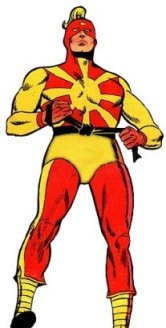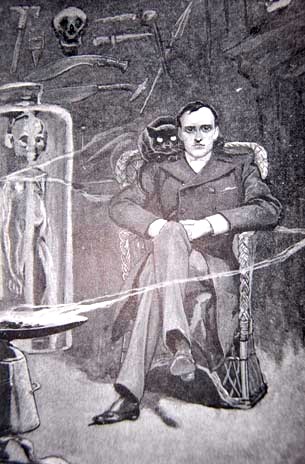Saturday, June 29, 2013
Enter Doctor Nikola!
Last summer when I was first beginning my reading of the misadventures of Doctor Fu-Manchu, my research turned up a name I'd never encountered before, Doctor Nikola, master villain and the creation of popular and prolific Australian author Guy Boothby. Used to kick off the publicaton of Windstor Magazine, a rival of the more famous and popular Strand Magazine, Nikola was a successful venture appearing ultimately in five novels. As pictured above, you can see he is a striking figure. A mysterious figure of odd olive skin, slick black hair, and magnetic eyes, the Doctor is rarely seen without his constant companion Apollyon, a massive cat which the Doctor often strokes as he plots and schemes.
We first meet Doctor Nikola in the prologue of the 1895 novel A Bid For Fortune (sometimes titled Enter Doctor Nikola). He is described in the prologue and he meets his trio of henchmen named Eastover, Baxter, and Pendergast. He then disappears into the background of his own debut, very much in the manner of Fu-Manchu, manipulating events and appearing mysteriously from time to time as his gang plot to pressure an English lord to turn over an enigmatic Chinese artifact. There is abundant kidnapping, sufficient fisticuffs, high-minded romance, and expansive travel across the globe as we learn Nikola's scheme, or seem to.
The hero and narrator of the novel is Richard Hatteras, an Anglo-Australian (like Boothby himself) of sharp mind and able body who has risen up by his own hard work to become a reasonably successful sailor and businessman. A side plot of the story has him become an English lord in a somewhat Dickensian fashion. He meets the love of his life, the daughter of Lord Weatherly, and while he and Phyllis romance one another Nikola's scheme unfolds around them. The novel depends a great deal on coincidence to make the plot work, a bit too much really, but not unlike Edgar Rice Burroughs, Boothby keeps the action moving quickly enough that you don't linger on these weaknesses.
Here is my favorite passage from the novel which describes Nikola's lair:
"To begin with, round the walls were arranged, at regular intervals, more than a dozen enormous bottles, each of which contained what looked, to me, only too much like human specimens pickled in some light-coloured fluid resembling spirits of wine. Between these gigantic but more than horrible receptacles were numberless smaller ones, holding other and even more dreadful remains; while on pedestals and stands, bolt upright and reclining, were skeletons of men, monkeys, and quite a hundred sorts of animals. The intervening spaces were filled with skulls, bones, and the apparatus for every kind of murder known to the fertile brain of man. There were European rifles, revolvers, bayonets, and swords; Italian stilettos, Turkish scimitars, Greek knives, Central African spears and poisoned arrows, Zulu knobkerries, Afghan yataghans, Malay krises, Sumatra blow-pipes, Chinese dirks, New Guinea head-catching implements, Australian spears and boomerangs, Polynesian stone hatchets, and numerous other weapons the names of which I cannot now remember. Mixed up with them were implements for every sort of wizardry known to the superstitious; from old-fashioned English love charms to African Obi sticks, from spiritualistic planchettes to the most horrible of Fijian death potions.
In the centre of the wall, opposite to where we stood, was a large fireplace of the fashion usually met with in old English manor-houses, and on either side of it a figure that nearly turned me sick with horror. That on the right hand was apparently a native of Northern India, if one might judge by his dress and complexion. He sat on the floor in a constrained attitude, accounted for by the fact that his head, which was at least three times too big for his body, was so heavy as to require an iron tripod with a ring or collar in the top of it to keep it from overbalancing him and bringing him to the floor. To add to the horror of this awful head, it was quite bald; the skin was drawn tensely over the bones, and upon this veins stood out as large as macaroni stems.
On the other side of the hearth was a creature half-ape and half-man—the like of which I remember once to have seen in a museum of monstrosities in Sydney, where, if my memory serves me, he was described upon the catalogue as a Burmese monkey-boy. He was chained to the wall in somewhat the same fashion as we had been, and was chattering and scratching for all the world like a monkey in a Zoo.
But, horrible as these things were, the greatest surprise of all was yet to come. For, standing at the heavy oaken table in the centre of the room, was a man I should have known anywhere if I had been permitted half a glance at him. It was Dr. Nikola."
There is an oddly open ending to the novel which then moves rather neatly into the second Nikola story published a year later and titled simply Doctor Nikola Returns. In this story the narrator is one Wilfred Bruce, an Englishman who has traveled extensively in China and parts similar acquiring a reputation which brings him to the attention of Doctor Nikola. Nikola hires Bruce to go with him under cover disguised as natives into the heart of China to find, at the danger of their own lives, the location of a legendary monastery where the ultimate secrets of life and death and more are reputedly to be discovered. Nikola is much more front and center in this story, so much so that he and Bruce work together throughout. Nikola comes across as a ruthless, but oddly loyal and strangely honorable man who at times seems more the hero of the narrative rather than a villain.
We see in this story more of Nikola's talents, especially his mesmerism, the ability to hypnotize his adversaries. It is suggested that Nikola has occult powers of other kinds, though these never come into play. Nikola is a truly grotesque character in a strangely weird world into which we get to travel for a time. Always you get the sense that you are only getting a glimpse of what is really going on and what is really at stake.
Both of these novels have been neatly collected by Wordworth Publications in the volume Dr Nikola Master Criminal. The two novels offer up a splendid yarn which moves along swiftly, especially the second one. In Nikola we meet a character who would've been a most worthy opponent for Sherlock Holmes, an extremely intelligent villain who treats his opponents according to his own peculiar code and who is possessed of no small amount of will and ambition.
Nikola would appear in three more novels, and presumably more would have been written had not Boothby died in 1905. As it stands, Doctor Nikola might well be one of the great literary creations few of us have heard about.
Rip Off
Subscribe to:
Post Comments (Atom)



Just got the Wordsworth edition, although I had read the first one years ago
ReplyDeleteEnjoy! The second novel is rather different in tone since we see so much of Nikola. Some of the weird mystery disappears, but it's replaced by some hefty action-adventure pieces.
DeleteRip Off